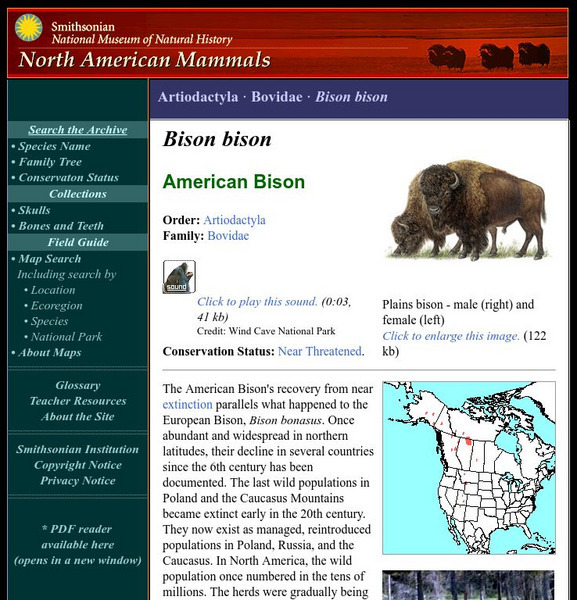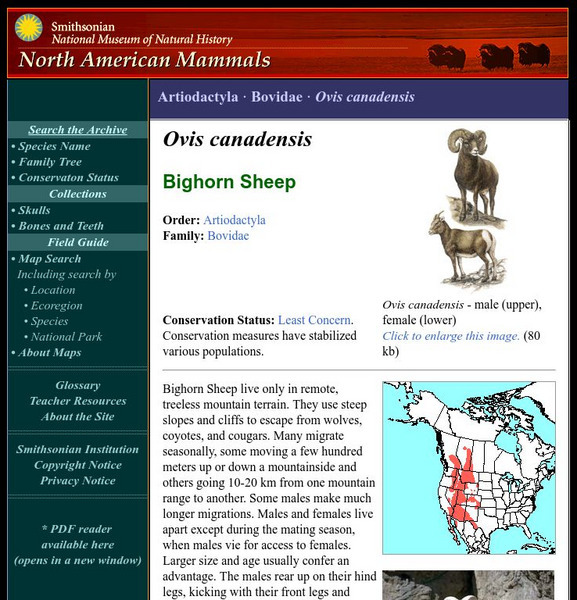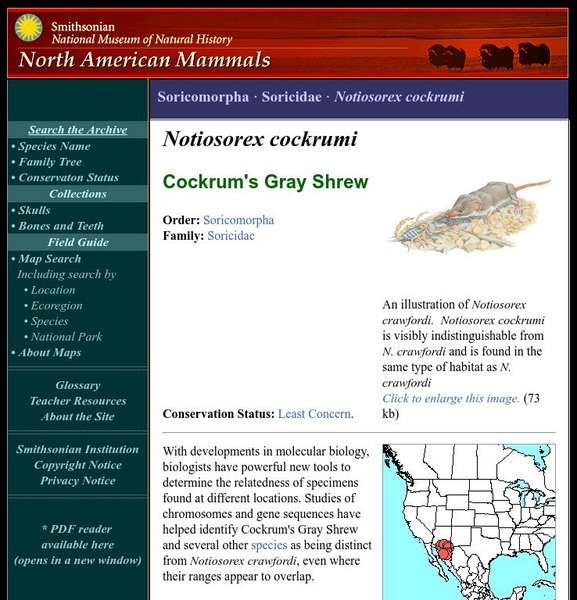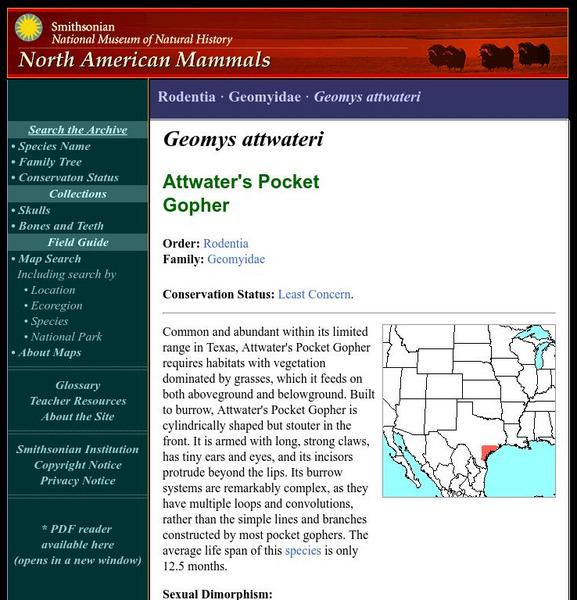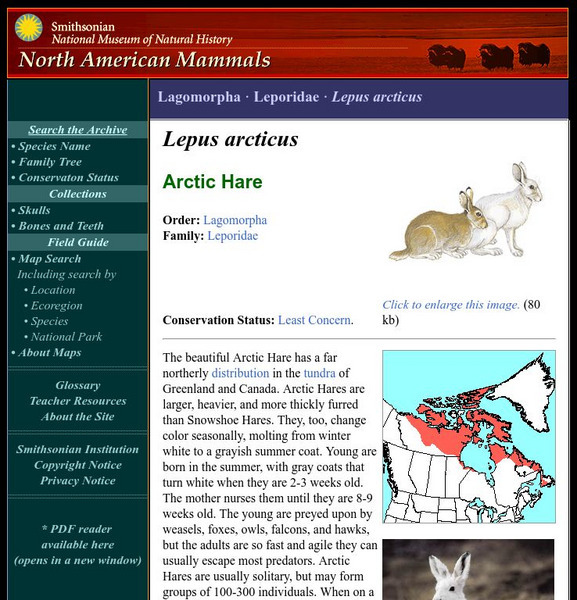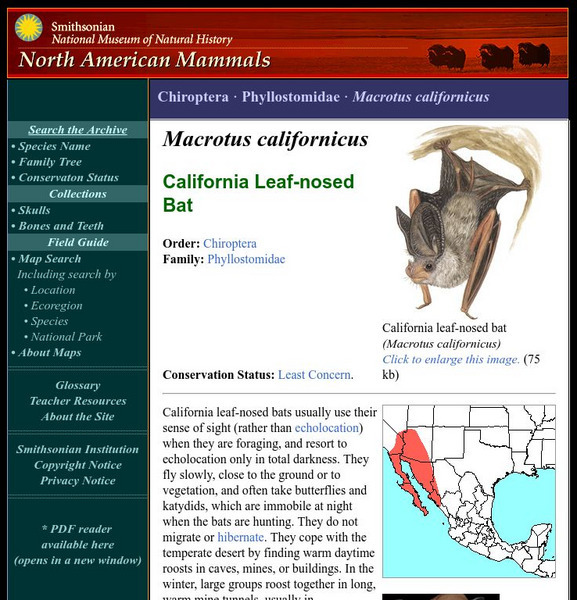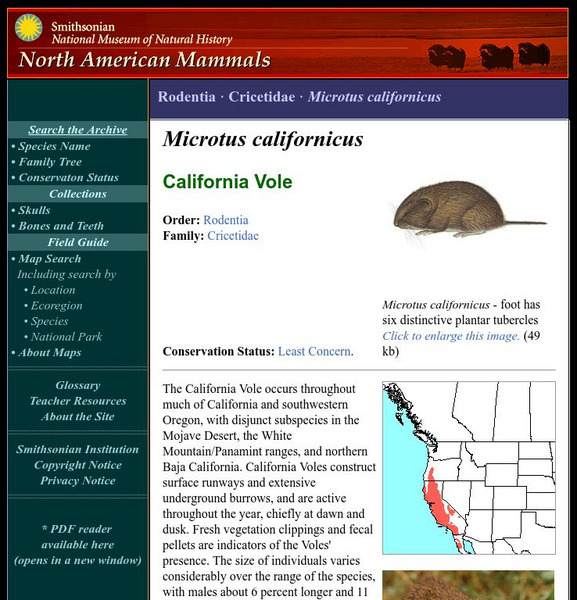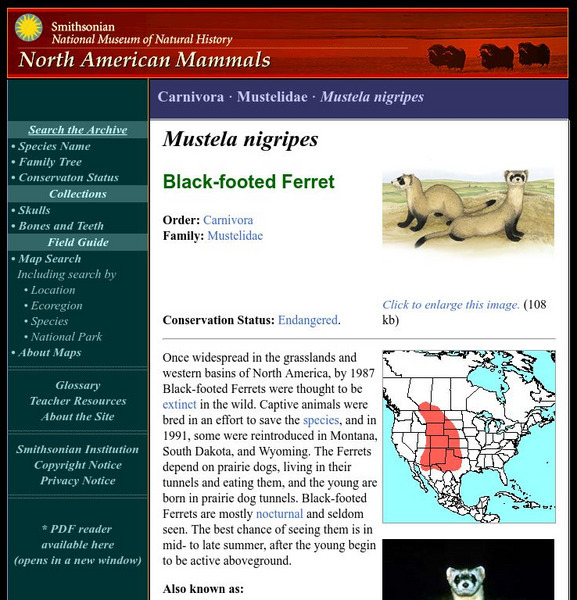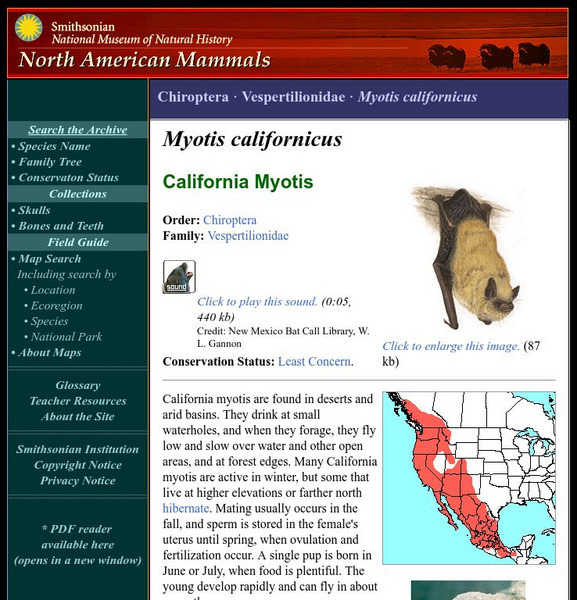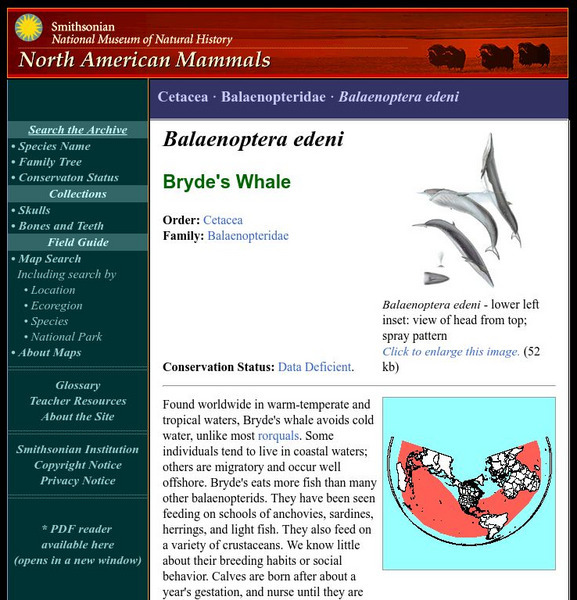Smithsonian Institution
National Museum of Natural History: American Mammals: Arctic Fox
An animal that does not begin to shiver until temperatures reach -70 C, the arctic fox is one of the most superbly cold-adapted mammals. Its dense, multi-layered coat, which is several inches thick during winter, provides excellent heat...
Smithsonian Institution
National Museum of Natural History: American Mammals: Baird's Beaked Whale
Baird's beaked whale is the longest species of the Ziphiidae, which is a family of medium-sized whales. The name "beaked whale" comes from the way the long snout, or rostrum, tapers to a tip. Learn more about the Berardius bairdii, more...
Smithsonian Institution
National Museum of Natural History: American Mammals: American Bison
The American Bison's recovery from near extinction parallels what happened to the European Bison, Bison bonasus. Once abundant and widespread in northern latitudes, their decline in several countries since the 6th century has been...
Smithsonian Institution
National Museum of Natural History: American Mammals: Bighorn Sheep
Bighorn Sheep live only in remote, treeless mountain terrain. They use steep slopes and cliffs to escape from wolves, coyotes, and cougars. Learn more about the Ovis canadensis, more commonly known as a Bighorn Sheep, in this...
Smithsonian Institution
National Museum of Natural History: American Mammals: Coast Mole
Coast Moles are difficult to distinguish from Townsend's Moles where their ranges overlap in the Pacific Northwest. Both have velvety, dark-gray fur and tiny eyes and ears that are hidden under their fur. Learn more about the Scapanus...
Smithsonian Institution
National Museum of Natural History: American Mammals: Baird's Shrew
Baird's Shrew has a very limited range in Oregon, in moist conifer forests. Its fur is darker brown in winter than in summer, when it is brownish-chestnut or olive-brown, with paler sides and belly. Learn more about the Sorex bairdi,...
Smithsonian Institution
National Museum of Natural History: American Mammals: Arizona Shrew
The Arizona Shrew was at first found only in Arizona, but it is now known to occur in New Mexico and northern Mexico as well. Until the 1990s, only about 22 specimens had ever been collected. Learn more about the Sorex arizonae, more...
Smithsonian Institution
National Museum of Natural History: American Mammals: Arctic Shrew
Arctic Shrews prefer grassy clearings and marshes within coniferous forests and are never very dense in population. Mortality is high early in life. Learn more about the Sorex arcticus, more commonly known as an Arctic Shrew, in this...
Smithsonian Institution
National Museum of Natural History: American Mammals: Cinereus Shrew
Mainly nocturnal and rarely seen, the Cinereus Shrew is nonetheless common and widespread below the timberline in northern deciduous and coniferous forests, in both wet and dry habitats. It is also known as the Masked Shrew and the...
Smithsonian Institution
National Museum of Natural History: American Mammals: Barren Ground Shrew
An inhabitant of the far north, the Barren Ground Shrew lives on the tundra from Point Barrow, Alaska, to the western shore of Hudson Bay, Canada. The fur on its back forms a well-defined brown stripe, and its sides and undersides are...
Smithsonian Institution
National Museum of Natural History: American Mammals: American Badger
Badgers look like short, shaggy, medium-sized dogs. They are powerful diggers. Learn more about the Taxidea taxus, more commonly known as an American Badger, in this easy-to-read species overview by the Smithsonian's National Museum of...
Smithsonian Institution
National Museum of Natural History: American Mammals: Cockrum's Gray Shrew
With developments in molecular biology, biologists have powerful new tools to determine the relatedness of specimens found at different locations. Studies of chromosomes and gene sequences have helped identify Cockrum's Gray Shrew and...
Smithsonian Institution
National Museum of Natural History: American Mammals: Attwater's Pocket Gopher
Common and abundant within its limited range in Texas, Attwater's Pocket Gopher requires habitats with vegetation dominated by grasses, which it feeds on both aboveground and belowground. Built to burrow, Attwater's Pocket Gopher is...
Smithsonian Institution
National Museum of Natural History: American Mammals: Allen's Big Eared Bat
As with other big-eared bats, the huge ears of Allen's big-eared bat can be curled back along the sides of the neck so they resemble the horns of a ram. When its ears are tucked out of the way in this manner, one of the cartilage folds...
Smithsonian Institution
National Museum of Natural History: American Mammals: Brown Lemming
Unlike Norwegian Lemmings, Brown Lemmings do not migrate en masse when they overpopulate their homes in the treeless regions of the north, but they do tend to wander. These are stout-bodied, herbivorous rodents with extremely short...
Smithsonian Institution
National Museum of Natural History: American Mammals: Arctic Hare
The beautiful Arctic Hare has a far northerly distribution in the tundra of Greenland and Canada. Arctic Hares are larger, heavier, and more thickly furred than Snowshoe Hares. Learn more about the Lepus arcticus, more commonly known as...
Smithsonian Institution
National Museum of Natural History: American Mammals: California Leaf Nosed Bat
California leaf-nosed bats usually use their sense of sight (rather than echolocation) when they are foraging, and resort to echolocation only in total darkness. They fly slowly, close to the ground or to vegetation, and often take...
Smithsonian Institution
National Museum of Natural History: American Mammals: Bowhead Whale
Bowheads live in icy Arctic seas. A smooth back with no dorsal fin, a blowhole placed in a high crown at the top of the head, and a thick layer of blubber for insulation equip them for this environment. Learn more about the Balaena...
Smithsonian Institution
National Museum of Natural History: American Mammals: California Vole
The California Vole occurs throughout much of California and southwestern Oregon, with disjunct subspecies in the Mojave Desert, the White Mountain/Panamint ranges, and northern Baja California. California Voles construct surface runways...
Smithsonian Institution
National Museum of Natural History: American Mammals: Beach Vole
Found only on Muskeget Island, the Beach Vole became isolated from its closest relative, the Meadow Vole, about 3,000 years ago during a glacial melt and rise in sea level. It is the only mammal endemic to Massachusetts, the result of...
Smithsonian Institution
National Museum of Natural History: American Mammals: Blue Whale
As far as we know, the blue whale is the largest animal ever to have existed on the planet. Weights up to 190,000 kg (as much as 30-40 African elephants) have been recorded. Learn more about the Balaenoptera musculus, more commonly known...
Smithsonian Institution
National Museum of Natural History: American Mammals: Black Footed Ferret
Once widespread in the grasslands and western basins of North America, by 1987 Black-footed Ferrets were thought to be extinct in the wild. Captive animals were bred in an effort to save the species, and in 1991, some were reintroduced...
Smithsonian Institution
National Museum of Natural History: American Mammals: California Myotis
California myotis are found in deserts and arid basins. They drink at small waterholes, and when they forage, they fly low and slow over water and other open areas, and at forest edges. Learn more about the Myotis californicus, more...
Smithsonian Institution
National Museum of Natural History: American Mammals: Bryde's Whale
Found worldwide in warm-temperate and tropical waters, Bryde's whale avoids cold water, unlike most rorquals. Some individuals tend to live in coastal waters; others are migratory and occur well offshore. Learn more about the...


